|
|
|
|
HPS Teaching Slideset
slides 1-13: General Overview of Hantaviruses
slides 1-13
slides 14-25
slides 26-28 slides
29-37 slides
38-43
Download or view
complete slideset as a PowerPoint Show
|
|

Slide 1
Hantavirus Pulmonary Syndrome
Hantavirus pulmonary syndrome (HPS), caused by a previously
unknown hantavirus, was first recognized in May 1993. The
disease begins with nonspecific symptoms that can include
fever, muscle aches, headache, abdominal pain, nausea, and
vomiting, followed later by coughing and shortness of breath.
The symptoms usually occur between 1 and 6 weeks after exposure
to virus-laden rodent excreta. The disease rapidly progresses
to cardiac and respiratory failure, requiring that the patient
receive intensive care.
|
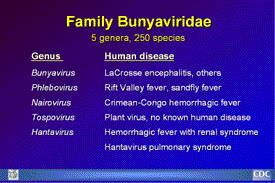
Slide 2
Family Bunyaviridae
Family Bunyaviridae: Hantaviruses are members of the family
Bunyaviridae, which consists of 5 genera and 250 species.
Hantaviruses can cause hantavirus pulmonary syndrome (HPS)
or hemorrhagic fever with renal syndrome (HFRS). The 5 genera
of Bunyaviridae include Bunyavirus, Phlebovirus, Nairovirus,
Tospovirus, and Hantavirus. |
|

Slide 3
Characteristics of Hantaviruses
Characteristics of Hantaviruses: Hantaviruses
are unique among Bunyaviridae genera in that they are not
associated with an arthropod vector. In general, a distinct
rodent species is the reservoir for each hantavirus. Transmission
of hantaviruses to humans most often occurs via inhalation
of aerosolized, virus-laden rodent excreta.
|

Slide 4
Transmission of Hantaviruses
Transmission of Hantaviruses: The virus is horizontally
transmitted between rodents through intraspecific aggressive
behaviors, such as biting. The virus is transmitted to humans
from aerosolized rodent excreta, particularly urine. Transmission
to humans also can occur from inhalation of secondary aerosols,
and from rodent bites or other direct contact of infectious
material with mucous membranes or broken skin. |

Slide 5
Phylogeny of Hantaviruses:
Based on Sequence of S Segment
Phylogeny of Hantaviruses, Based on the Sequence of the
S Segment (one of three genomic RNA segments): This phylogenetic
tree depicts the relationship among the viruses, the primary
rodent reservoir of the virus, and the geographic origin
of the characterized virus. |

Slide 6
Phylogeny of Hantaviruses:
Based on Sequence of M Segment
Phylogeny of Hantaviruses, Based on the Sequence of the
M Segment (one of three genomic RNA segments): This phylogenetic
tree depicts the relationship among the viruses, the primary
rodent reservoir of the virus, and the geographic origin
of the characterized virus. |
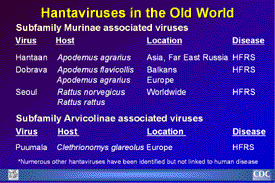
Slide 7
Hantaviruses in the Old World
Hantaviruses in the Old World: At least four Old World hantaviruses
-- Hantaan, Dobrava, Seoul, and Puumala viruses -- can cause
hemorrhagic fever with renal syndrome (HFRS) and are endemic
in parts of Europe and Asia. Murine rodents carry Hantaan,
Dobrava, and Seoul viruses. An Arvicoline rodent species
carries Puumala virus, which causes a milder form of HFRS.
Numerous other Old World hantaviruses have been identified
but have not been linked to human disease. |
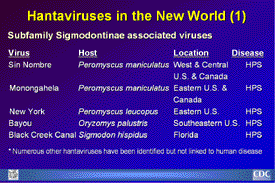
Slide 8
Hantaviruses in the New World (1)
Hantaviruses in the New World -- North America: Hantaviruses
in the New World are associated with hantavirus pulmonary
syndrome (HPS). Sigmodontine rodents carry the hantaviruses
that cause HPS and are found throughout the Americas. Sin
Nombre virus, carried by Peromyscus maniculatus, is the
predominant cause of HPS in the United States and Canada.
Mononghela, New York, Bayou, and Black Creek Canal viruses
also cause HPS and are found in eastern Canada and eastern
and southeastern United States. Numerous other hantaviruses
have been identified but have not been linked to human disease.
|

Slide 9
Hantaviruses in the New World (2)
Hantaviruses in the New World - South and Central America:
In South and Central America, hantaviruses that have been
identified as causing HPS are Andes virus in Argentina and
Chile; Andes-like viruses including Oran, Lechiguanas, and
Hu39694 in Argentina; Laguna Negra virus in Bolivia and
Paraguay; Bermejo virus in Argentina; Juquitiba virus in
Brazil; and Choclo virus in Panama. Numerous other hantaviruses
have been identified but have not been linked to human disease.
|

Slide 10
New World Hantaviruses Map
A map of Western Hemisphere shows the distribution of New
World hantaviruses and their associated rodent hosts. The
viruses in bold print cause disease in humans including:
Sin Nombre, Choclo, Orán, Andes, New York, Bayou,
Black Creek Canal, Juquitiba, Laguna Negra, Hu39694, and
Lechiguanas. Virus (Rodent Host)
Sin Nombre (Peromyscus maniculatus)
Muleshoe (Sigmodon hispidus)
Isla Vista (Microtus californicus)
El Moro Canyon (Reithrodontomys megalotis)
Calabazo (Zygodontomys brevicauda)
Choclo (Oligoryzomys fulvescens)
Caño Delgadito (Sigmodon alstoni)
Rio Mamore (Oligoryzomys microtis)
Orán (Oligoryzomys longicaudatus)
Bermejo (Oligoryzomys chacoensis)
Andes (Oligoryzomys longicaudatus)
New York (Peromyscus leupous)
Prospect Hill (Microtus pennsylcanicus)
Bloodland Lake (Microtus ochrogaster)
Bayou (Oryzomys palustris)
Black Creek Canal (Sigmodon hispidus)
Rio Segundo (Reithrodontomys mexicanus)
Juquitiba (Unknown host)
Laguna Negra (Calomys laucha)
Maciel (Necromys benefactus)
Hu39694 (Unknown host)
Lechiguanas (Oligoryzomys flavescens)
Pergamino (Akodon azarae)
|
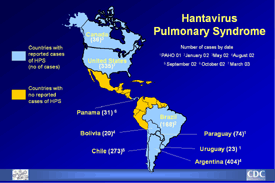
Slide 11
Hantavirus Case Numbers
A map of Western Hemisphere shows the number of cases
of Hantavirus Pulmonary Syndrome in the respective country.
Country (Number of Cases)
Argentina (404)
Brazil (168)
Bolivia (20)
Canada (36)
Chile (273)
Panama (31)
Paraguay (74)
United States (335)
Uruguay (23)
|

Slide 12
Rodent Carrier Images
Deer Mouse (Peromyscus maniculatus) and Cotton Rat (Sigmodon
hispidus): The deer mouse is the primary rodent host for
Sin Nombre virus, the main etiologic agent of HPS in North
America. The cotton rat is the primary rodent host for the
Black Creek Canal virus. Infected rodents show no visible
evidence of acute or chronic infection. |
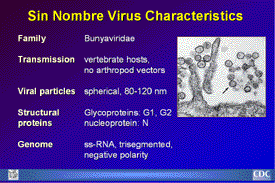
Slide 13
Sin Nombre Virus Characteristics
Characteristics of Sin Nombre Virus: Sin Nombre virus belongs
to the family Bunyaviradae and contains three genomic RNA
segments of negative polarity. The virion of Sin Nombre
virus is spherical and is 80-120nm in diameter. The virion
contains two glycoproteins, G1 and G2, located on the outer
surface, which are the nucleoprotein and the viral polymerase.
|
|
|
|
|
slides 1-13 slides
14-25 slides
26-28 slides
29-37 slides
38-43
Download or view complete slideset as a PowerPoint Show
 All About Hantaviruses Home
| General Information | Technical Information
| Contact Us All About Hantaviruses Home
| General Information | Technical Information
| Contact Us
CDC Home
| Search
| Health Topics A-Z |
Accessibility
This page last reviewed
Friday, June 18, 2004
Special Pathogens Branch
Division of Viral and Rickettsial Diseases
National Center for Infectious Diseases
Centers for Disease Control and Prevention
U.S. Department of Health and Human Services
 
|
|

 National
Center for Infectious Diseases
National
Center for Infectious Diseases National
Center for Infectious Diseases
National
Center for Infectious Diseases